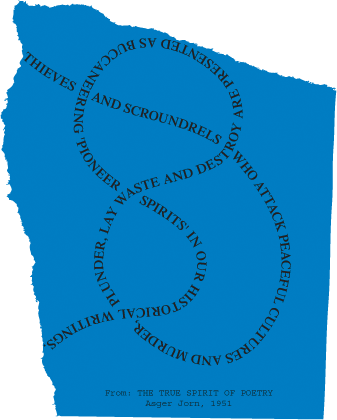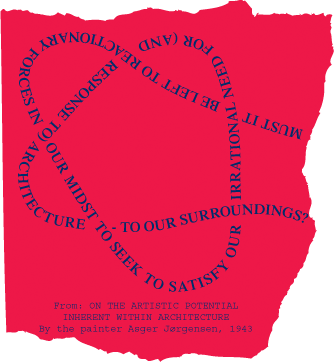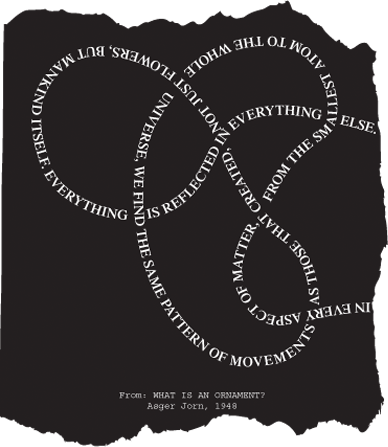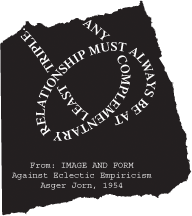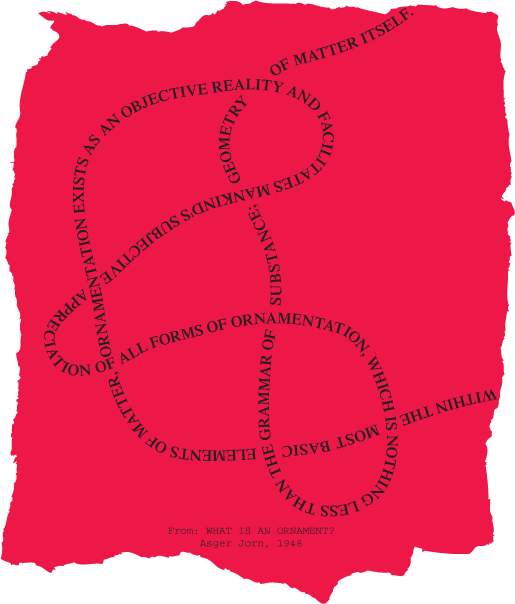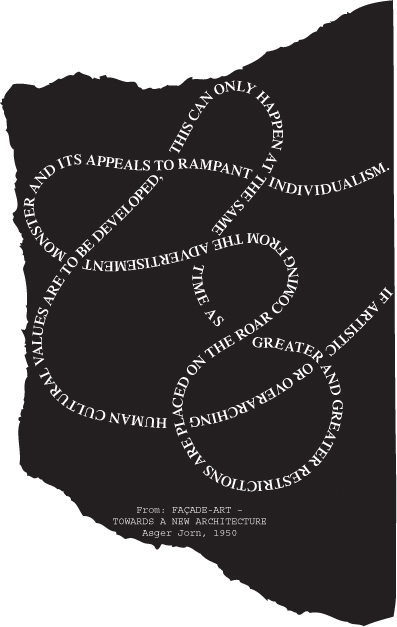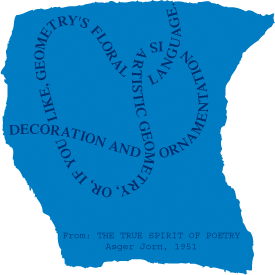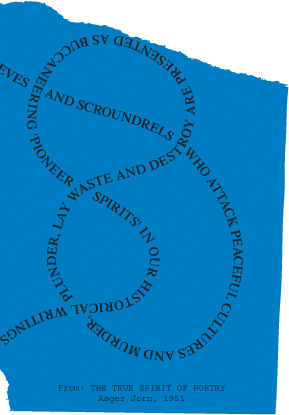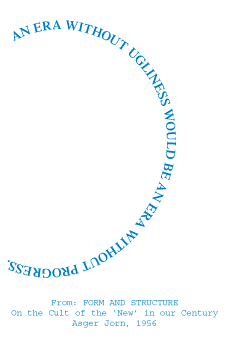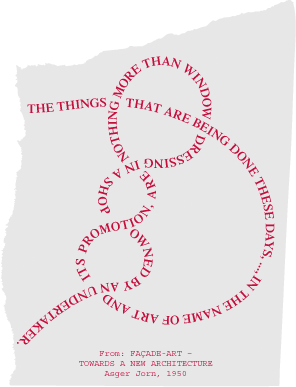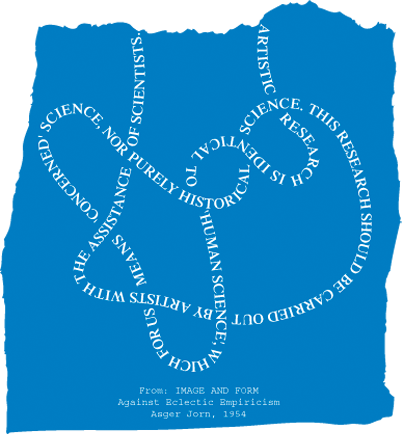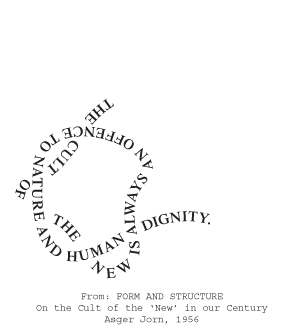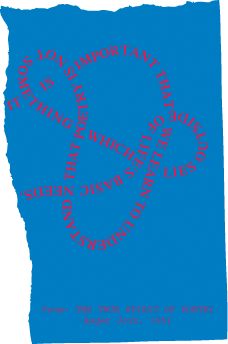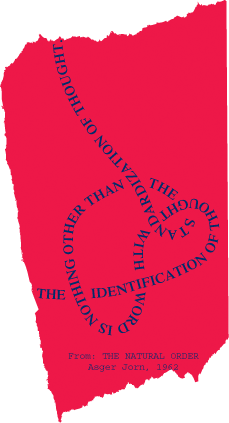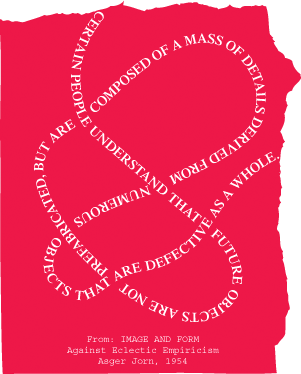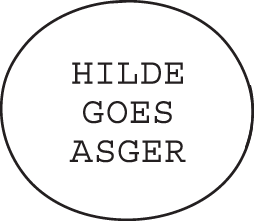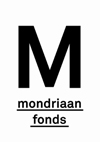AUTHENTIC IRONIES
The text below is an interview that was conducted with Karen Kurczynski in May 2015. Karen Kurczynski is Assistant Professor of Modern and Contemporary Art History at the University of Massachusetts, Amherst, USA and author of the recent publication The Art and Politics of Asger Jorn – The Avant-Garde Won’t Give Up, Ashgate, 2014. A slightly different version of this interview is published in the framework of the Art in Context Programme of the Rietveld Academy, Amsterdam in collaboration with the Cobra Museum for Modern Art. The theme for 2014/2015 was ‘laughter’.
HdB: The Danish experimental artist and thinker Asger Jorn (1914-1973) is well-known for being one of the co-founders of the postwar experimental artists’ group Cobra (1948-1951), and the Situationist International (SI), a movement of artists and intellectuals who strove to achieve social change (1957-1972). Many of those who study Jorn’s oil paintings, etchings, lithographies and other work, will find themselves smiling or even laughing about his puns and parodies, ironic or sometimes tongue-in-cheek humor. In your recent publication The Art and Politics of Asger Jorn: The Avant-Garde Won’t Give Up, Ashgate, 2014, the chapter ‘Authetic Ironies’ discusses the critical and expressive operations of Asger Jorn’s mature paintings, including parody. Here, you identify irony, parody and related strategies as a key element to understanding Jorn’s work, as “foundational to the social nature of Jorn’s aesthetic as a whole …”. Are you aware of previous art historical texts which attribute a similar value to Jorn’s ironizing (including self-ironizing)?
KK: This is an interesting aspect for me to consider now, as I work on an exhibition on Cobra for the NSU Art Museum in Florida (which will end at the Cobra Museum). Because Cobra was not interested in irony at all—or at least, that is what Christian Dotremont writes in one of his key texts, “Par la grande porte” (1949, in a catalog from Colette Allendy Gallery): “They are against ironic painting, which actually tries to express the organic joy of the universe, the historic joy of the world of 1949, but which is ashamed and which trims down the aesthetic impulse […] with an elegant little intellectual penknife.” Jorn too was more interested in authenticity in the Cobra years: he associated irony with the ruling class in his large c. 1947 manuscript “Blade af kunstens bog.” He then explored irony along with humorous strategies more and more over the course of the 1950s. In fact he was always interested in humor in art and in writing, co-authoring a parodic article on a Functionalist named “Everclean” in 1948. Already in his 1952 text Held og hasard, a very Nietzschean text, he rejects the idea of authentic expression. Then by the mid-50s, he openly espouses irony and “lying.” Historiographically, this is precisely the moment his art work begins to be celebrated on an international stage. The critics and curators like Werner Haftmann who wrote about it, however, emphasized it as a return to angst-filled expressionism. Contemporary critics especially in the US, where Jorn’s work is less well known, have continued to dismiss his work as expressionist (or worse, neo-expressionist—ironic and therefore empty) until very recently, after 2000. There are not many art-historical texts that place a high value on irony per se or self-ironizing in Jorn’s work until very recently, when suddenly that issue is becoming ubiquitous. I can’t think of any writer or curator who took his irony seriously until the 21st century, and now I can’t think of any who don’t take it seriously. Those who knew Jorn personally, like John Lefebre and Lawrence Alloway, certainly commented on his humor. It is really the writers you and I know now, our colleagues like Helle Brøns and Axel Heil, who are bringing this aspect into sharper focus today. It’s also related to the evolution of art historiography in general. Jorn (and Cobra) were not taken seriously because their work wasn’t perceived as “serious”—one of the most important key terms in postwar movements like Abstract Expressionism—so writers like Haftmann and Guy Atkins had to present his oeuvre as a serious engagement with major artistic themes. We are in a very different, much more interesting, moment now when artists contribute more writing on art and have helped influenced art critics and historians to recognize the importance of humor and play.
HdB: Irony and parody could be looked upon as a highly self-defensive modes, allowing someone to avert responsibility, to be indirect. However in the title of your chapter the words ‘ironies’ and ‘authentic’ are happily married. This seems to be a contradiction in terms but reading the chapter reveals that you locate the actual criticality and complexity of Jorn’s strategy in the dynamics between both elements. I would be curious to learn more about your perspective on the development of these dynamics. The ‘Authentic Ironies’ chapter discusses parody as a critical operation mostly in relation to work from the end of the 1950s into the 1960’s but (as you also mention) the concepts of irony and artifice are part of the development of Jorn’s aesthetic theory from the Cobra period (1948-1951) onwards. May I ask why you felt it was necessary to make this chronological distinction?
KK: The chronological distinction is really just part of the structure of the book, which focuses each chapter around a theoretical issue (in this case, expressionism and irony) combined with a particular temporal and artistic focus (in this case, Jorn’s mature painting ca. 1957-62). Jorn is interested in humor and play in art from the beginning, from his 30s Miró- and Klee-inspired works onward through Helhesten and Cobra. But I focused on different issues in my accounts of the earlier periods. Also, as I just mentioned, Jorn’s humor and irony come out much more explicitly in his late 50s and early 60s work than at any other period. Each chapter of my book has a title which is a deliberate contradiction, an oxy moron, in a Jornian spirit. It’s the clash of Jorn’s irony in a postwar age so obsessed with authenticity that gives his work such interest, and his position seems newly significant to us now as artists are returning to issues of abstraction and gestural painting but in an extremely sophisticated and sometimes overtly political way, combining abstraction and expressivity with some of the irony associated with pop art, appropriated imagery, and now digital mash-ups—when in the 50s and 60s those two approaches were strictly separated by generation. Recent artists are more interested in combining the best of both generations—the spontaneity and human element in the gesture, but without making it too specialized or spectacular; the humor and sophistication of using appropriated imagery but without it being too easy or celebratory. Jorn’s work does all of this. Today we have a much more sophisticated, “situational” understanding of identity and authenticity in the internet age, and new recognition of the importance of play in the era of video games and “gamification,” that I think makes Jorn’s work seem prescient and newly relevant.
HdB: The following question I have appropriated from a conversation with Jouke Kleerebezem, one of the tutors of the Rietveld Art in Context programme. He was wondering if we could touch upon the type of ambiguity that typifies humor in general, making the ‘laughter’ that results from it an acquired taste, always debatable between those who differ in their sense of humor. So then I wondered if you think Jorn shot himself in the foot every once in a while, and whether he perhaps did not care?
KK: Did Jorn shoot himself in the foot sometimes? Yes. Did he not care? No he did not care. His hits were so on target that I think they excuse a lot of misses that would stand out more in the work of an artist whose work was less complex and multifaceted. He always kept moving which is one of the fascinating things about his work and his artistic practice—it was also a source of heartbreak for those around him, from his wives and girlfriends to his kids, who suffered immensely, and his friends and gallerists. In terms of his humor, take a work like Masculine Resistance at the Museum Jorn, and you can see the retrograde gendered assumptions about the interaction of men and women that make its humor sort of fail from my own feminist perspective today (Helle Brøns has written about the gender confrontation in this work). But at the same time, the failure is itself interesting. It has something to tell us about mainstream gender attitudes in Jorn’s day, on the one hand, and it has a very critical message about the discourses of authenticity and transcendence that characterized art in his day, on the other. Its emphatic vulgarity in both how it was painted and the subject itself is a biting critique and a liberating rejection of the abstract painting that was dominant at the time. So it’s not humor as in a joke, which is always socially divisive (some of the best comics are the most offensive ones—Sarah Silverman for example). It’s more like meta-humor because the humor is always embedded in multiple and contradictory discourses. Jorn’s work is humorous in a way comparable to Richard Prince or Glenn Ligon’s “joke” paintings, which repaint a racist or sexist joke on a monochrome canvas, despite their radically different aesthetics. Whether you laugh at the joke is only part of the point—it makes you stand back and start thinking about what it means to laugh at it in different contexts, as well as (and this is key) the fact that the joke is always so culturally specific that it’s immediately outmoded and, well, no longer funny. So even Jorn at his most sexist or short-sighted has potentially important meanings for us. At the same time, just to negate everything I’ve just said (another Jornian move), I think you can also find passages of sheer physical humor in Jorn’s paintings that might be more universal—the way physical comedy appeals to a wider audience. You can also find references to carnivalesque themes and popular humor as seen in earlier painters like Bruegel and Bosch, and writers like Rabelais who Jorn loved. There are many different forms of humor present in Jorn’s work.
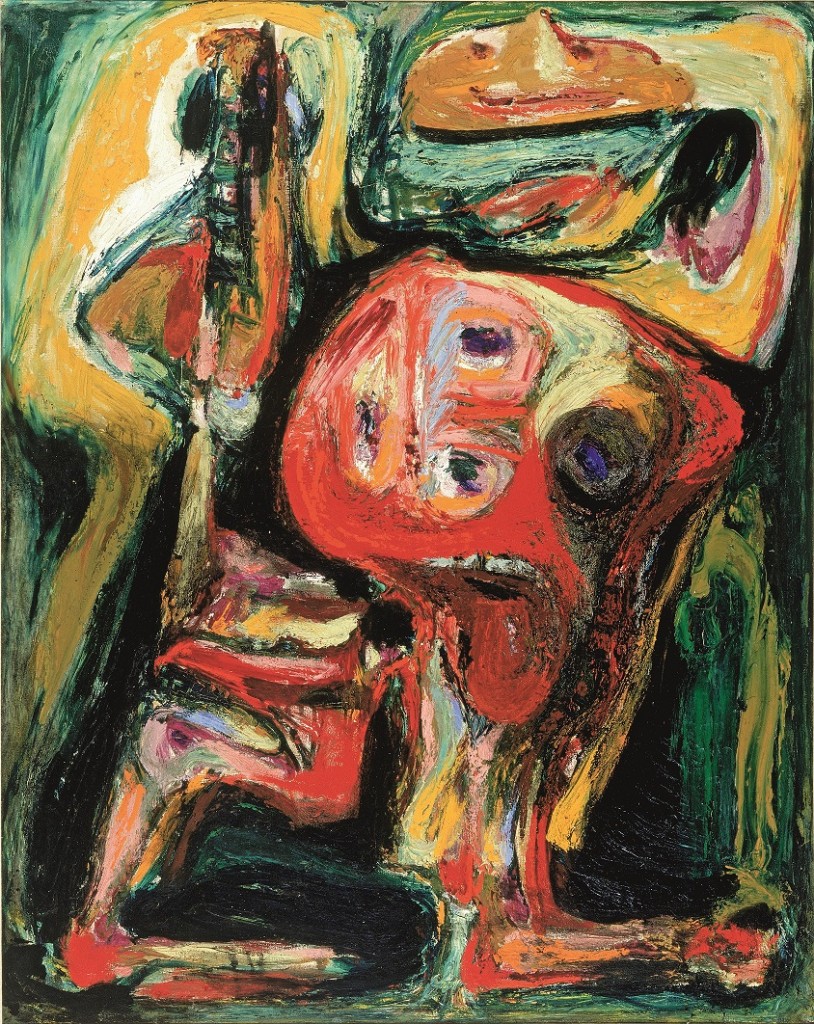
Asger Jorn, ‘Le faux rire (image tragi-comique)’, oil on canvas, 1954. Longterm loan by ABN-AMRO to the Cobra Museum of Modern Art, Amstelveen. Photograph: Henni van Beek
HdB: In 1954 Jorn made an oil painting that literally depicts laughter: Le faux rire (image tragi-comique) which translates as The Fake Laughter (tragic-comic image). At the bottom of the painting we see a (literally) two-faced laughing character in a slightly awkard, half-reclining position while holding something up in the air with one arm. In the background above the laughing character hovers a smaller, friendly looking face. Although the painting is the representation of a fake emotion it funnily enough simulaneously brings across a genuine emotion, the mix of twisted feelings that potentially come with a fake laugh (discomfort? repulsion?). I would like to invite you to closer examine this painting from the perspective of ‘authentic ironies’. In relation to Jorn’s paintings La double Face (The Double Face) and Le Cri (The Scream) you for instance bring up notions such as multiplicity, clichés of the representation of human emotion, the understanding of complexity of the self as a social situation, and Jorn’s insistence on meaning-production as an active process.
KK: This is a great work to bring into focus the complexity and multiple dimensions of laughter we just touched on. The image strikes me as very grotesque in its combination of comic and tragic—humor and angst—in a particularly puzzling combination. The history of the grotesque from ancient times (when it was called the “monstrous”) to the present, as many scholars have demonstrated, typically combines humor with horror. So it relates to a prominent theme in human culture. We can all think of examples of situations that are horrible or harmful that, when considered at a remove, can also be really funny (though at the time it was still largely taboo in Europe to produce humorous imagery relating to the Second World War—Jorn’s work plays with those taboos only indirectly). This image features not just those two dimensions of tragedy and comedy, but also a third, the question of “fake” laughter. The issue of something fake destroys any notion of authenticity and cuts through any attempt to securely define something. Then, Jorn began his painting Stalingrad, le non-lieu, ou le fou rire du courage, the same year—the first title of that painting was “Le fou rire” (Mad Laughter) and it may or may not have been a reference to history or history painting or the “mad laughter of courage” in an epic battle at that point. It acquired the title Stalingrad a bit later. Jorn loved puns and I think it’s likely that he linked le fou rire and le faux rire together deliberately. Fou being a reference to an authentic expression; faux indicating irony and inauthenticity. What strikes me about this image is that it seems more troubling than funny, so is it about laughter at all? Or really, it’s precisely about laughter rather than explicitly funny. It is about the significance of laughter. Laughter and play are elements that rational society suppresses and they indicate a critical distance, a resistance to power. They are also intimately linked to creativity itself and the ideas of play and experiment so prominent in Cobra. Laughter indicates a double perspective. The main figure is not just laughing, but sticking out his tongue, which is a gesture of childishness, defiance, as well as disgust; a gesture referenced earlier in Cobra and examined in Jorn’s later book La langue verte et la cuite. The material fleshiness of the painting is also striking. Parts of figures evoke blood and bones, the mouth and the tongue, the eyes made grotesque as they multiply and roll in all directions. It’s an image of illness (recalling Jorn’s abstract portrait of his injured cousin Mads in the Silent Myth murals) and madness, so strongly linked to creativity. It’s also a visceral painting that affects us in an almost physiological way. As it was made in Italy, this was part of Jorn’s reaction against the sleekness of postwar design culture and his investigation of ceramics at the time. It’s a great example of his interest in Bachelardian ideas of the “material imagination.” It is grotesque because it fails to cohere as a recognizable group of figures. Instead it conveys the process of signification. Maybe it even conveys the process of creating humor itself, and its flipside, tragedy itself, out of the neutral facts of what happens in the world. There is also a recognition implicit here (but signified by the contradictions inherent in the title) that the process of signification is always social. So what one calls greatness, another calls tragedy, and yet another calls humor.
